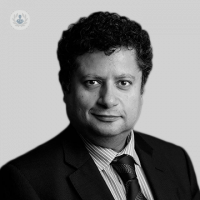A common cause of back pain: a guide to degenerative spine disease
Escrito por:Back pain and issues surrounding it are a common problem these days, particularly in the UK with its ageing population. A common cause of back pain is degenerative spine disease - but what exactly is the condition? Professor Keyoumars Ashkan, leading neurosurgeon from the London Neurosurgery Partnership, explains more.

What is degenerative spine disease?
Degenerative spine disease (DSD), is actually a more general term which encompasses arthritic (otherwise known as spondylotic) and degenerative disc disease, either with or without compression on the nerves, or instability in the spine. It is one of the most common causes of lower back pain and neck pain.
Who is affected by degenerative spine disease?
DSD is relatively common in the Western world, due to its ageing population. Degenerative spine conditions usually develop as a consequence of the natural ageing process rather than a specific disease, or they can develop due to overexertion and overuse. Most people over the age of 40 experience some degree of degeneration, with people over 70 even more commonly and severely affected.
DSD can less commonly develop as a result of trauma, genetic predisposition, infection, inflammation, or other types of medical condition.
What are the symptoms of DSD?
The primary symptom of DSD is axial pain, which refers to pain distribution in the lower back, upper back or the neck area. This pain does not travel to other areas of the body, and is confined to the site of origin.
Other symptoms experienced depend on where the source of the disease is, how quickly it develops, and if there is neural compression involved.
For example, a narrowed spinal canal or slipped disc can lead to compression of the spinal cord/nerve roots, which can cause radiating pain (like sciatica), a sensation of pins and needles (paraesthesia), or even numbness/ weakness in the limbs. Over time, patients may notice that they lose manual dexterity, and find actions such as opening jars difficult. Other associated symptoms may be problems with controlling bowel and bladder movements.
How is DSD diagnosed?
DSD can be investigated through a number of tests, such as diagnostic imaging including MRI & CT scans. The patient may also be evaluated by using tests that look at the function of the nerves, called nerve conduction studies.
How can DSD be managed?
DSD is best managed with a multidisciplinary team, meaning the patient has access to professionals across a range of specialties – at the very least, neurosurgeons, pain specialists and physiotherapists.
Patients with DSD represent a large percentage of those seen at a neurosurgical clinic, but this does not mean that surgery is always the route followed when it comes to treatment. The condition is usually first tackled using methods such as exercise programmes, physical therapy (including osteopathy, treatment with a chiropractor, or physiotherapy), and drug treatments administered orally or through injection.
When is surgery considered for DSD?
In patients who experience severe radiating pain like sciatica which fails to respond to non surgical treatments, or in whom weakness in the limbs develops, surgery is considered as a treatment option. Surgery aims to relieve pressure on the nerves, improving the pain and facilitating neurological recovery for the patient.
In patients who experience pure back pain, with no radiating pain in the limbs, surgery is controversial. In selected patients, such as those who have spinal instability, a type of surgery called spinal fusion can be effective as treatment. For others, there are now new devices, called spinal cord stimulators, which can be placed surgically in close proximity to the spinal cord to deliver ultra-high frequency stimulation which have proved beneficial in treating back pain. Ultimately, when considering surgery and treatment, it is important to consult a specialist and decide together what the best course of action will be.


